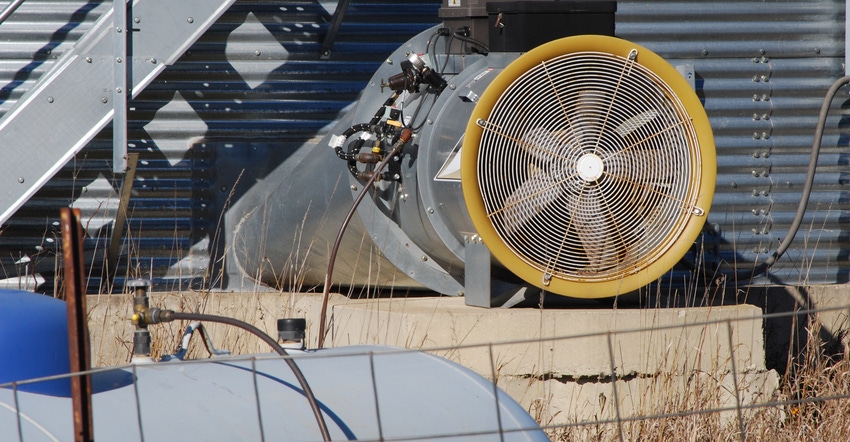
With low corn and soybean prices and big carryover supplies from last year, a lot of grain will be held in farm bins through summer, into fall and some into next year, too. You need to keep stored grain in good condition. What steps should you take?
It’s important to keep the grain cool going into spring and summer, says Greg Brenneman, an Iowa State University Extension ag engineering specialist. Some warming of stored grain has already occurred during warmer weather this spring and with the sun shining on the south side of grain bins.
“Ideally, we like to keep stored grain temperatures below 40 degrees F going into summer. By keeping grain as cool as possible, we can limit insect activity and growth of spoilage molds,” Brenneman says.
Aerating grain
There were opportunities in winter and early spring to aerate stored grain to cool it to below 40 degrees. If you didn’t get your stored corn and soybeans cooled to 40 degrees or below, what should you do now in May? You aren’t likely to get 40-degree temperatures in mid-May or later.
Brenneman says it takes about 15 hours for a large drying fan (rated at 1 hp per 1,000 bushels) to completely change the temperature of the grain in a full bin. A small aeration fan (a tenth horsepower) may take five to six days to completely cool a full bin. So even if the outdoor temperature drops to 40 degrees some night in May, you’re unlikely to get the entire bin of grain completely cooled down to 40 degrees by running the fan.
If you do aerate grain in late spring or during the summer, “Keep a close eye on the fans and the weather so you don't inadvertently warm the grain back up when outdoor temperatures increase,” he cautions.
Moving corn
Some corn went into storage late last fall at 15% to 16% grain moisture as it came out of the field. It’s important to get this corn moved or dried before going into summer, Brenneman says. To store grain safely during summer, maximum moisture content is 13% to 14% for corn and 11% for soybeans.
“Mold growth will occur at summer temperatures if the grain exceeds these moisture contents,” he says. The allowable storage time for 15% moisture corn is about four months at 70 degrees and only about two months at 80 degrees. These two numbers are grain temperatures he is referring to, not outdoor air temperatures.
Keep grain cool
Because grain is a good insulator, during the summer most of the warming will occur at the surface of the grain. You need to provide an air inlet near the bin roof eave and an outlet near the peak to reduce the hot air in the top of the bin, Brenneman says.
Similar to venting an attic, the heated air rises and is exhausted at the peak. A ventilation fan to exhaust the hot air from the top of the bin is another option.
During summer, run the aeration fan for a few hours to push air up through the cool stored grain to cool the grain near the top of the bin. Pick a cool morning every two to three weeks during summer to run the aeration fan, and only run the fan a few hours to minimize heating of grain at the bottom of the bin.
“You should cover aeration fans when they are not operating to prevent additional heating of the grain,” Brenneman says. “If you don’t cover the fan, outside warm air will enter. The wind and a natural chimney effect will push warm, moist spring air through the grain, warming it and possibly adding some moisture.”
Monitor grain temps
Monitoring grain for temperature and moisture content is essential. Brenneman advises farmers to use temperature sensors in the bin to help determine if stored grain is at risk from mold and insect development. Rising grain temperature may indicate insect or mold problems. Insect infestations can increase from barely noticeable to major infestations in three to four weeks when grain is warm.
Temperature cables in bins are a helpful tool, but they only measure the temperature of the grain next to the sensor.
Because grain is an excellent insulator, the grain temperature may be significantly different just a few feet from the sensor and not affect the measured temperature. Whether you are installing one temperature cable or several in a bin, place a temperature cable a few feet from the south wall of a bin.
Grain temperature cables are a good tool, but don’t rely on them to replace inspections of stored grain for insects, crusting, odors or other indicators of storage problems. It’s still a good idea to turn the fan on and smell the first air that comes out of the grain, Brenneman says, when you check each bin on a regular schedule, once every two weeks or so.
For more information on proper grain storage practices, the Iowa Grain Quality Initiative has free online learning modules to help educate and teach farmers and other grain handlers proper grain storage techniques. Topics include dryeration, aeration and fan performance. Visit extension.iastate.edu/grain for information about the modules.
About the Author(s)
You May Also Like




